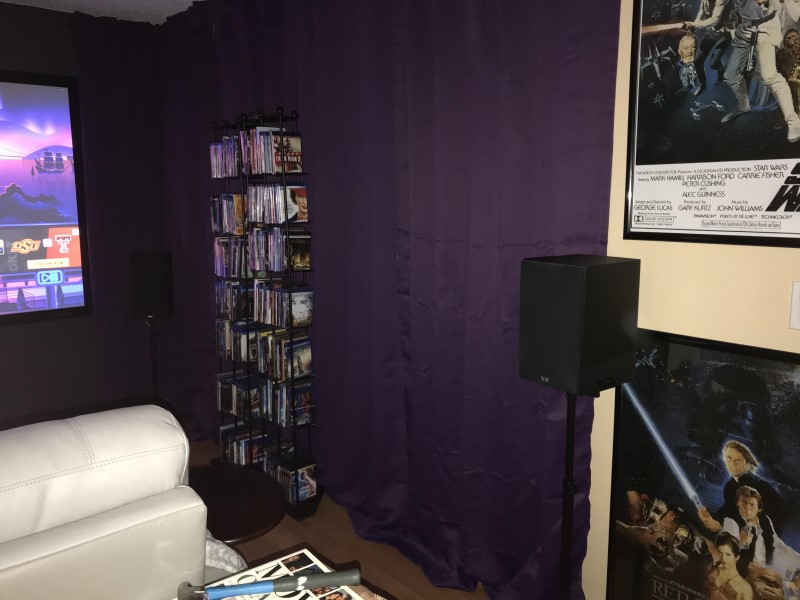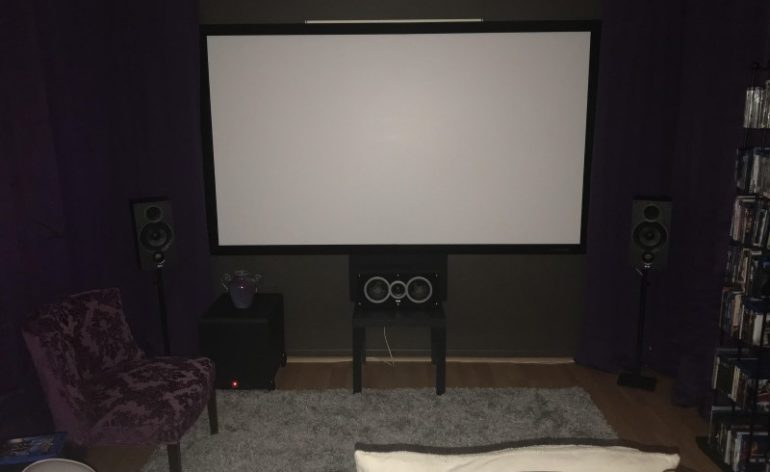The Best Wall Color for Home Theater
When we first get in to home theater, the horizon looks endless. There are speakers to audition, wires to run, and subwoofers to place. Just when you think you are done, someone tells you about room acoustics and you find yourself spending a weekend in a garage making your own room treatments. The possibilities seem endless. Home theater seems like a hobby that will never end.
Until it does.
We know it seems impossible, but people contact the AV Rant Podcast all the time asking about “upgrades” that are literally just them wanting to change something. Anything. Surely they could do something to make their home theater better?
Welcome to your wall color. Yes, there is a best color for your home theater walls.
Why Wall Color Matters for Home Theater

If you think about cinemas, they usually have curtains everywhere. Sometimes they carpet the walls. The idea is that the wall coverings are dark in color and are plush. That plushness absorbs light. What they don’t want is the light to reflect off the walls and back to the viewers.
The number one thing to remember is that our eyes are very sensitive to color. Regardless if you have a direct view or projection screen, the light from the image will bounce off the walls. That reflected light will do a number of things to your perception of the image. If the wall color is too light, it will reduce the perceived contrast of the image. If the color is too dramatic (think orange, red, blue, etc.) that light can bounce back to the screen and skew the color of the image.
Unfortunately, we usually don’t have the ability to carpet our walls. That means we need to choose a paint that will act similarly in our home theater for the best performance.
Back in Black

In a perfect world, you’d paint your home theater black. The walls, the ceiling, black carpet on the floor, black furniture…everything. You’d wear black clothes, a black balaclava, and paint any exposed skin black (explain that to your family and friends). If you were REALLY serious, you’d get black contacts for your eyes so that the light couldn’t bounce off your sclera (the white parts of your eyes).
So…yeah, that’s a bit extreme.
The extreme idea outlined above is designed to absolutely kill any light reflecting around your room. In less extreme examples, people will paint the wall where their screen lives black. They may hang black velvet on the wall, side walls within their view, and tack it up to the ceiling. Anything to black out the area around the screen. This makes sure the only light that is coming from the front of the room is from the screen.
The Downsides of Blacking Out Your Home Theater
If you are using a projection system or anything that isn’t an OLED, the black parts of your screen really aren’t as black as you think they are. For all the other direct-view technologies out there, they utilize a backlight that has to be dimmed. Only OLED can dim each individual pixel. That means your LED (or QLED, QNED, or Neo QLED) displays have areas that will look more grey than black.
Projectors are even worse.
You can get around this by adding bias lighting. This adds light around your screen so that the perceived contrast is increased. But you just spent a bunch of money and time blacking out the front of your theater. Why would you want to add more light?
The Compromise
Our favorite compromise for wall color is Sherwin Williams Grey Screen paint (link). Like many paint colors, the Grey Screen paint has a number of sister colors in the same family. The upside of this color is that it is completely neutral. It doesn’t have a little more blue or red or any other color in it. That means that any light bouncing off it will not be color-shifted in any way.
We suggest you get some samples of the different shades and see which you can live with in your home theater. Go as dark as possible. With grey being a very hot wall color right now, there is no better time to introduce this home theater change to your significant other. Personally, we didn’t bother bringing up painting the ceiling grey to our significant other. You may be braver than us.
The Results
After you repaint your home theater, will you notice a huge difference in the quality of the image in your home theater? You might. If you are going from a completely white room to one that is much, much darker, you could experience better contrast. If the walls were a funky color, you could experience better colors.
Most likely, the improvements will be subtle.
This question is best asked by those that are building a new home theater from scratch. We believe that the paint for any room in your home, much less your theater, shouldn’t look out of place with the rest of the rooms. Having a crazy home theater that is optimized for viewing but looks odd compared to the rest of the house can make selling your home later more difficult. If you want a fully optimized home theater, more power to you. Paint the whole room black. But if you want to have a home theater that makes aesthetics compromises, we totally get that and we give you our blessing. This Sherwin Williams paint is very good and certainly shows that you cared about performance. Paint with confidence!


